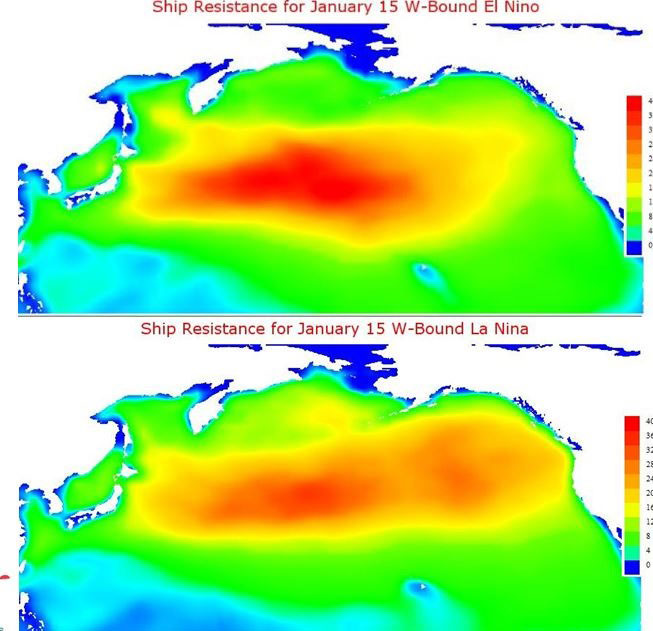El Nino's Impact on Voyage Optimization
By Joshua Redinger, Route Analyst, AWT
There has been considerable discussion recently within the meteorological and oceanographic community about the return of El Niño in the next few months. According to the latest analysis from the NOAA Climate Prediction Center, there is a 65% chance of a weak to moderate El Niño emerging during the fall and early winter seasons of 2014 in the Northern Hemisphere. El Niño is a naturally occurring environmental process in which the waters of the central and eastern equatorial Pacific become untypically warm, and this process has a unique and prominent impact on global weather and trade routes. This article will explore some of the environmental phenomena and what AWT Route Advisory Services undertake to optimize your voyages during El Niño events.
El Niño's effects are felt all over the world. For instance, a severe El Niño will enhance the jet stream over the western Pacific and shift it eastward, leading to stronger winter storms over California and the southern United States. In contrast, El Niño can also cause severe droughts over Australia, Indonesia and parts of Southern Asia. While El Niño is known to prevent tropical storms from developing into hurricanes in the Atlantic Ocean and Gulf of Mexico, during hurricane season (June to November), it increases the chances of cyclones and typhoons over the eastern tropical North Pacific.

Above image shows climatological ship resistance during a typical El Niño (top) and La Niña (bottom) season.
By examining seasonal climate conditions in previous El Niño years, AWT has identified several impacts to shipping associated with the phenomenon. Some of these are discussed below:
• A weakening of the easterly trade winds across the equatorial Pacific, and an associated decrease in the strength of west-setting equatorial currents. As a result, typical routes that look to take advantage of long duration sailing within the equatorial currents can become less advantageous during an El Niño year. This also decreases the negative effects of sailing near the equator on eastbound voyages from the Far East or Australia to western Central or South America, as El Niño promotes stronger east-setting counter currents.
• A stronger jet stream across the central North Pacific, which enhances the low latitude storm track, and as a result northern routes across the Pacific can become more favorable, and a decision to load a vessel to summer marks for cross-Pacific transit can result in extreme time loss for those ships transiting to/from the west coast of the U.S. and Canada.
• Long period waves, generated by the above-mentioned low-latitude storm track, may generate adverse port conditions in western South America.
• Conversely, the ports along the coasts of Indonesia, Australia, as well as those located on the eastern coasts of Asia and South America typically experience a great decrease in annual precipitation during El Niño. As a result, vessels proceeding to these regions often experience benign weather and calmer than normal sea states.
• Western Atlantic storms will likely be stronger than normal, perhaps greatly disrupting vessels sailing to/from the U.S. East Coast and coastal shipping. These heavy weather diversions brought about by El Niño will be further complicated this upcoming winter by the North American Emission Control Area, which requires vessels to burn more expensive ultra low-sulfur fuel and more complicated analysis may be required in order to reduce total voyage costs while also keeping vessels clear of extreme conditions.
• While long term route planning is inherently difficult when taking into consideration tropical cyclones, a general decrease in the amount of delays caused by cyclones can be expected in regions with reduced activity such as the North Atlantic, with more frequent route diversions expected in regions such as the eastern North Pacific.
• As global weather patterns change, there are varied influences on the global agricultural trade. For example, drier than average conditions can lead to decreased grain production in Australia, decreased rice production in Southeast Asia, and decreased banana production in northern South America and Central America. As agricultural production decreases in those regions, increased demand can be expected where production has been less affected. Regions that have had supplies reduced will be forced to compensate by increasing agricultural imports, which will subsequently impact the bulker market.
• El Niño can also have a significant impact on loading operations that are sensitive to rain. El Niño typically increases rainfall in southern North America from late fall through the spring, and in southeastern South America from the early spring through the summer. Therefore more frequent delays can be expected for vessels loading moisture sensitive cargo in those regions.
How Does AWT Prepare for These Changes?

that matters most
Get the latest maritime news delivered to your inbox daily.
AWT utilizes proprietary technology to improve safety and ETA projections when selecting the optimum route. Climatological Ship Resistance (CSR) uses the speed loss due to historical wind and wave data since 2000 for different ship types and stratifies the data based on weather patterns such as El Niño, La Niña and Neutral periods. The results provide significant improvement over simulating or optimizing a route using climatological weather.
AWT noted in a statement: "AWT's commitment to innovation drove us to develop this unique product to assist shipping companies with the challenges presented by these varying short-term weather patterns. Our staff closely monitors the changing environment, working to develop strategies to meet the needs of our clients while benefiting from the understanding of phenomena like El Niño, and how it impacts your vessels at sea and our global economy."
